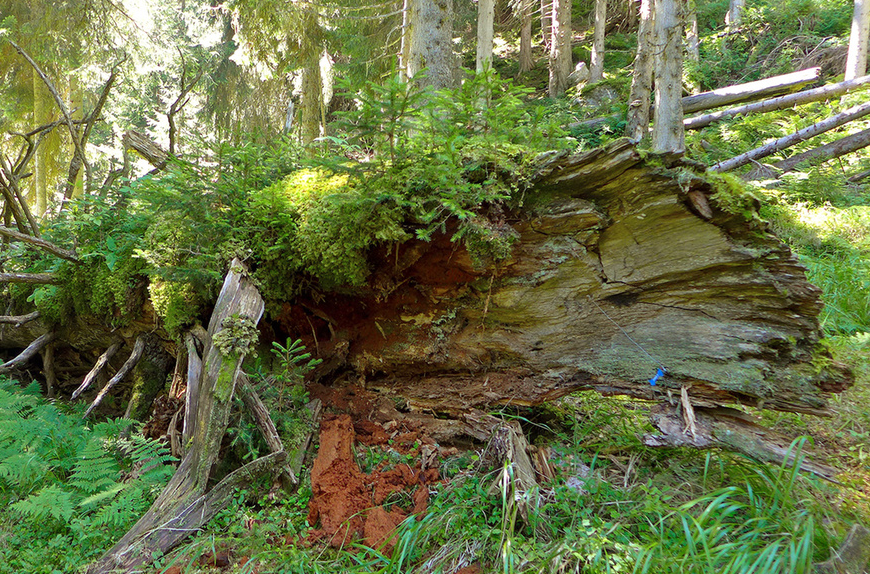
To support biodiversity, forests need dead trees as well. Though it has more than it used to, Switzerland could use more deadwood. Urs-Beat Brändli, WSL
Despite threats such as drought and insects, Swiss forests are better equipped to handle natural hazards than they were a decade ago.
There’s also more diversity in terms of the types of trees found in Swiss woodlands, according to the forest inventory report presented on Wednesday.
Detailed monitoring since 1983 has helped the Swiss authorities evaluate the condition and development of the nation’s forests, which cover about a third of the country. The latest inventory, the fourth of its kind, is based on research conducted from 2009-2017. It’s the joint effort of the federal environment office (FOEN) and the Swiss Federal Institute for Forest, Snow and Landscape Research (WSL).
“The development of Swiss forests since the first inventory is generally a success story, despite major damage due to natural events,” noted Urs-Beat Brändli, senior scientist at WSL. “Over the past eight years, forest management has become more sustainable in many areas. But there are some problematic issues like intense wildlife browsing and the partial inaccessibility of mountain woodlands.”
More trees
The inventory, completed via samples across the country, registered growth in terms of the variety of tree species as well as the overall area of Swiss forests. Between 2009 and 2017, Switzerland gained 15 football pitches’ worth of forest per day, thanks mainly to alpine meadows returning to their original forest state.
Yet fewer than half of the mountain forests are easily accessible for wood harvesting. This makes it difficult and expensive to maintain them, and as their trees grow taller and thicker, young trees struggle to establish themselves.
At the same time, deer and other animals feast on young oaks and white fir trees, both valuable species in forests that protect roads and settlements from landslides and avalanches. According to the inventory, some 42% of Swiss forest land plays this protective role.
Having a mix of tree species and ages helps forests in general to survive storms, pests and climate change. Hotter and drier phases put a severe strain on trees, making them more vulnerable to severe weather, diseases as well as insects like the bark beetle.
“Structurally, Swiss forests are adapting to climate change,” said Michael Reinhard, head of FOEN’s forest division. For example, there are more mixed-species forests in the midlands. “This development must continue through consistent measures, with the government providing financial support to forest owners.”
But not all new trees are welcome: invasive species, such as the cherry laurel and Chinese windmill palm, remain a concern.
Natural resource
In recent years there has been an increase in forest planning as well as in the amount of certified woodland. But the inventory found that 21% of Swiss forests are unmanaged, representing an “undesirable” development. Despite the surplus local supply, cheaper imported wood remains attractive.
Swiss forests are also a popular destination for leisure activities, as seen especially during the coronavirus lockdown. And while littering is an issue throughout Switzerland, the forest inventory noted a decrease in the amount of rubbish being dumped in Swiss woods.
With so many demands on forests – as well as potential threats – how do foresters go forward?
“It’s a challenge for foresters to find the right path for the future. When’s the next big storm? When will the bark beetles come back? That’s why we need forests with a certain resilience, that can adapt to different situations,” said WSL Deputy Director Christoph Hegg, highlighting the importance of having a variety of trees to maintain a healthy forest. “But the forest doesn’t need people. The forest will survive anyhow.” The next Swiss forest inventory is already in the works.
Full story here Are you the author? Previous post See more for Next postTags: Latest news,newsletter
























